AMD Frame Pacing Explored: Catalyst 13.8 Brings Consistency to Crossfire
by Ryan Smith on August 1, 2013 2:00 PM ESTCatalyst 13.8 Results in Summary
For this article we’ve decided to do things a bit differently and lead in with a summary of our results, rather than starting with detailed results and then going to a summary. Based on past feedback most of you want to quickly know whether this works at all and how well it works, which is something we can quickly cover first before diving into individual games.
We’ll start with the graph that is of the most importance: delta percentages on a 7990, comparing Catalyst 13.6b2 to Catalyst 13.8b1 with frame pacing enabled.
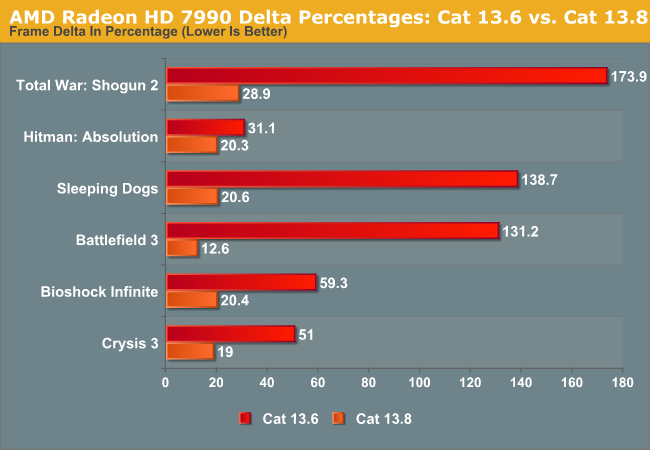
The results, quite frankly, speak for themselves. In roughly half of our 6 games AMD had absolutely absurd frame pacing on Catalyst 13.6. Total War, Sleeping Dogs, and Battlefield 3 all had massive pacing issues that were the result of second frames coming far too soon after first frames, leading to a high instance of “runt” frames – that is frames that are only shown for an incredibly short period of time before being replaced with a newer frame. These are the games where micro-stuttering and/or the feeling of lower frame rates would be the most apparent.
Earlier we decided that our cutoff would be 15%-20% for an “acceptable” range for delta percentages on a multi-GPU setup, and with the exception of Total War: Shogun 2 (the only non-action game in this collection), AMD has just managed to hit that. How smooth this is going to be perceived is going to vary on a person-by-person basis, but this is right where we’d say micro-stuttering and other issues become generally unnoticeable.
For the more visually inclined, we’ve also quickly cooked up frame time graphs in FCAT showing the two 7990s. The full series is below, but we’ll print in full the Total War: Shogun 2 graph in full since it was one of the bigger problem cases for AMD’s cards without frame pacing. Shogun doesn’t have any scene transitions, but it does have some snap camera movements that leads to a clear separation between scenes. In each scene we can clearly see the much lower variability with Catalyst 13.8 with frame pacing turned on, as opposed to 13.6 with frame pacing turned off.
Similarly, turning off frame pacing results results in Catalyst 13.6-like behavior, with much higher variability compared to having frame pacing turned on.
Moving on, the next question on most readers’ minds will probably be performance. What’s the performance sacrifice for using this new frame pacing mechanism? AMD said that the performance hit should be non-existent, and strictly speaking within Catalyst 13.8 that’s true, as we get identical frame rates with it on or off. However compared to Catalyst 13.6 we are seeing a performance regression.
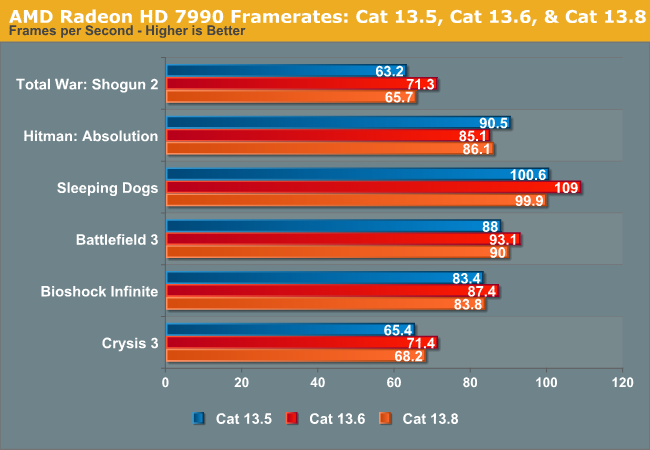
With the exception of Hitman: Absolution, performance is down across the board on 13.8 versus 13.6. The specific performance losses vary on the game, but we’re looking at 5-10%. However compared to the 13.5 launch drivers and again with the exception of Hitman AMD’s performance has held constant or increased. So at the very least when it comes to frame rates AMD is no worse off than they were at the launch of the 7990.
Our next summary graph is plotting the 7970GE against a pair of 7970GEs in Crossfire, to take a fresh look at AFR (Crossfire) versus a single GPU. Our editorial position has been and remains that we favor a single larger GPU over a pair of smaller GPUs when this approach is practical, and this chart demonstrates exactly why.
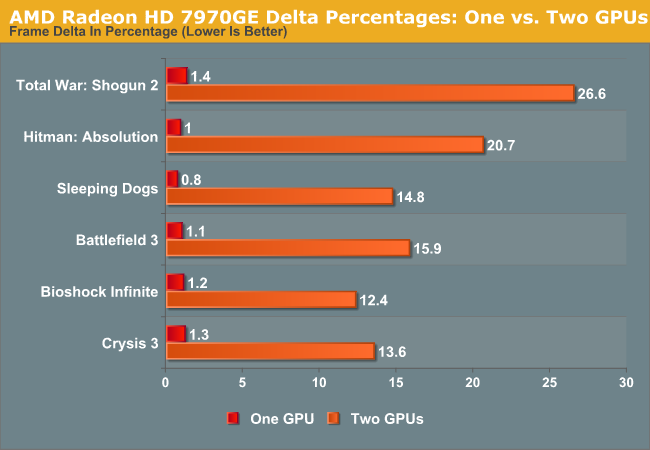
The delta percentages on the single 7970GE are all under 2%, versus 12%+ for the Crossfire setup. AFR simply cannot match the consistency of a single GPU at this time, which is why a high AFR is best left to being pursued after single-GPU performance has been exhausted.









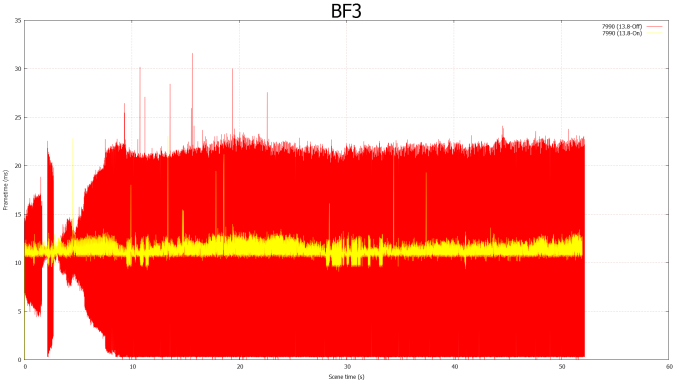
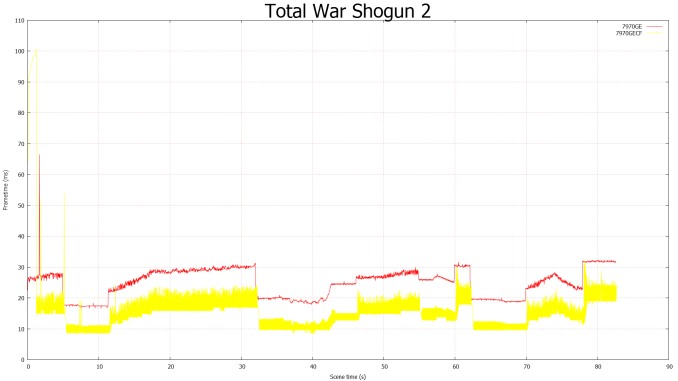














102 Comments
View All Comments
chizow - Friday, August 2, 2013 - link
That makes sense, but I guess the bigger concern from the outset was how AMD's allowance of runtframes/microstutter in an "all out performance" mentality might have overstated their performance. You found in your review that AMD performance typically dropped 5-10% as a result of this fix, that should certainly be considered, especially if AMD isn't doing a good job of making sure they implement this frame time fix across all their drivers, games, APIs etc.Also, any word whether this is a driver-level fix or an game-specific profile optimization (like CF, SLI, AA profiles)?
Ryan Smith - Friday, August 2, 2013 - link
The performance aspect is a bit weird. To be honest I'm not sure why performance was up with Cat 13.6 in the first place. For a mature platform like Tahiti it's unusual.As for the fix, AMD has always presented it as being a driver level fix. Now there are still individual game-level optimizations - AMD is currently trying to do something about Far Cry 3's generally terrible consistency, for example (an act I'm convinced is equivalent to parting the Red Sea) - but the basic frame pacing mechanism is universal.
Thanny - Thursday, August 1, 2013 - link
Perhaps this will be the end of the ludicrous "runt" frame concept.All frames with vsync disabled are runts, since they are never completely displayed. With a sufficiently fast graphics card and/or sufficiently less complex game, every frame will be a runt even by the arbitrary definitions you find at sites like this.
And all the while, nothing at all is ever said about the most hideous artifact of all - screen tearing.
Asik - Thursday, August 1, 2013 - link
There is a simple and definite fix for tearing artifacts and you mention it yourself - vsync. If screen tearing bothers you, and I think it should bother most people, you should keep vsync on at all times.chizow - Thursday, August 1, 2013 - link
Vsync or frame limiters are certainly workarounds, but it also introduces input lag and largely negates the benefit of having multiple powerful GPUs to begin with. A 120Hz monitor would increase the headroom for Vsync, but also by nature reduces the need for Vsync (there's much less tearing).krutou - Friday, August 2, 2013 - link
Triple buffering solves tearing without introducing significant input lag. VSync is essentially triple buffering + frame limiter + timing funny business.I have a feeling that Nvidia's implementation of VSync might actually not have input lag due to their frame metering technology.
Relevant: http://www.anandtech.com/show/2794/3
chizow - Saturday, August 3, 2013 - link
Yes this is certainly true, when I was on 60Hz I would always enable Triple Buffering when available, however, TB isn't the norm and few games implemented it natively. Even fewer implemented it correctly, most use a 3 frame render ahead queue, similar to the Nvidia driver forcing it which is essentially a driver hack for DX.Having said all that, TB does still have some input lag even at 120Hz even with Nvidia Vsync compared to 120Hz without Vsync (my preferred method of gaming now when not using 3D).
vegemeister - Monday, August 5, 2013 - link
The amount of tearing is independent the refresh rate of your monitor. If you have vsync off, every frame rendered creates a tear line. If you are drawing frames at 80Hz without vsync, you are going to see a tear every 1/80 of a second no matter what the refresh rate of your screen is. The only difference is that a 60Hz screen would occasionally have two tear lines on screen at once.chizow - Thursday, August 1, 2013 - link
Sorry, not even remotely close to true. Runt frames were literally tiny shreds of frames followed by full frames, unlike normal screen tearing with Vsync off that results in 1/3 or more of the frame being updated at a time, consistently.The difference is, one method does provide the impression of fluidity and change from one frame to the next (with palpable tearing) whereas runt frames are literally worthless unless you think 3-4 rows worth of image followed by full images provides any meaningful sense of motion.
I do love the term "runt frame" though, an anachronism in the tech world born of AMD's ineptitude with regard to CrossFire. I for one will miss it.
Thanny - Thursday, August 1, 2013 - link
You're not making sense. All frames with vsync off are partial. The frame buffer is replaced in the middle of screen updates, so no rendered frame is ever displayed completely.A sense of motion is achieved by displaying different frames in a time sequence. It has nothing to do with showing parts of different frames in the same screen refresh.
And vsync adds a maximum latency of the inverse of the screen refresh (16.67ms for a 60Hz display). On average, it will be half that. If you have a very laggy monitor (Overdrive-TN, PVA, or MVA panel types), that tiny bump from vsync might push the display lag to noticeability. For plain TN and IPS panels (not to mention CRT), there will be no detectable display lag with vsync on.